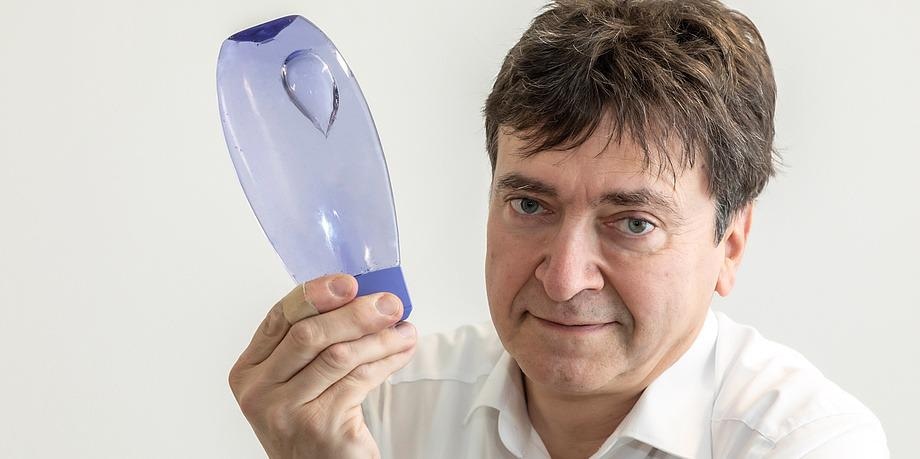Scientists at Graz University of Technology reveal the reason why gas bubbles in viscoelastic liquids (like polymer and protein solutions) rise so much quicker than previously thought.
 Günter Brenn investigates the behavior of gas bubbles and liquid drops at the Institute of Fluid Mechanics and Heat Transfer at TU Graz. Image Credit: Lunghammer-Graz University of Technology.
Günter Brenn investigates the behavior of gas bubbles and liquid drops at the Institute of Fluid Mechanics and Heat Transfer at TU Graz. Image Credit: Lunghammer-Graz University of Technology.
A jump discontinuity in the increased velocity of gas bubbles in so-called viscoelastic fluids is a puzzle long known amongst experts and is extremely relevant in several industrial production processes. Viscoelastic fluids are substances that integrate characteristics of liquid and elastic substances.
Various hair shampoos are an example of this. If a transparent, almost filled bottle of shampoo is turned upside down, the enclosed air rises as a bubble in a strange shape. In several industrial processes, such liquids occur as solutions of polymers and have to be frequently enriched with oxygen by gassing.
We have known for about 60 years that the rise velocity of gas bubbles in viscoelastic liquids undergoes a jump at a critical bubble diameter. The speed of the bubbles can then suddenly become up to ten times faster. This plays a fundamental role in the controlled gassing of these liquids. At the same time, it was unclear what was causing this sudden increase in velocity.
Günter Brenn, Institute of Fluid Mechanics and Heat Transfer, Graz University of Technology
With a combination of simulation, experiment and theoretical analysis, Günter Brenn's team at TU Graz and Dieter Bothe at TU Darmstadt have collaboratively solved the challenge. They have discovered that the interaction of the polymer molecules with the flow around the gas bubbles results in the strange velocity behavior of the bubbles.
With this knowledge, the oxygen input into such solutions can be predicted more precisely, which implies that equipment in process engineering, biotechnology and the pharmaceutical industry, for instance, could be developed in a better way. The study was published in the Journal of Non-Newtonian Fluid Mechanics.
“Relaxed” State Preferred
Polymers frequently consist of huge molecules that interact in complex ways with the liquid in which they are dissolved. This interaction makes the liquid viscoelastic. The reason behind the jump in velocity that gas bubbles display in such liquids from the crucial diameter onwards is further explained by Günter Brenn.
The flow around the bubble causes the dissolved polymer molecules to stretch. The molecules do not particularly like this state. They want to return to the relaxed, unstretched state as soon as possible.
Günter Brenn, Institute of Fluid Mechanics and Heat Transfer, Graz University of Technology
If this return to the relaxed state is faster than the molecules’ transport to the bubble’s equator, the bubble will remain slow. If, on the other hand, returning to a relaxed state takes longer than the journey to the equator of the bubble, tension in the fluid that “pushes” the bubble is released.
As a result, subsequent polymer molecules position themselves below the equator and relax, unloading their elastic energy and releasing a “propulsive force,” leading to self-amplification.
Besides the high practical relevance of this finding, particularly for the above-mentioned areas of application, there are also impacts in fundamental research.
It turned out that another surprising property of the flow field of these solutions can be assigned to this molecular mechanism we showed: namely, the so-called ‘negative wake’ of the gas bubble.
Dieter Bothe, Analysis Working Group, Department of Mathematics, Technische Universität Darmstadt
This is a region in the flow field below the bubble where the fluid normally “follows” the bubble at a low velocity. But polymeric liquids are the other way round: there, the movement of the liquid has been oriented in the opposite direction to the bubble’s movement.
This fluid movement leads to the same tension that “pushes” the bubble. This understanding could result in possibilities for regulating flow processes.
Journal Reference:
Bothe, D., et al. (2022) On the molecular mechanism behind the bubble rise velocity jump discontinuity in viscoelastic liquids. Journal of Non-Newtonian Fluid Mechanics. doi.org/10.1016/j.jnnfm.2022.104748